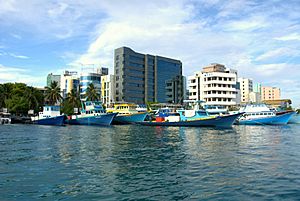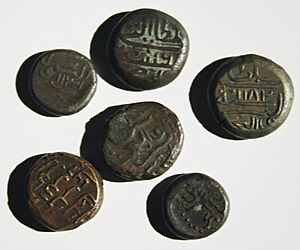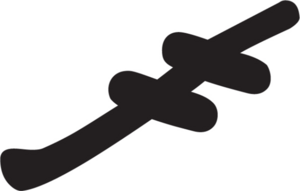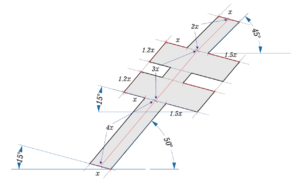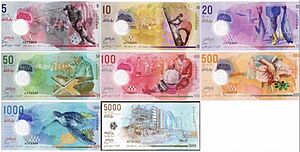Maldivian rufiyaa facts for kids
Quick facts for kids Maldivian rufiyaa |
||||
|---|---|---|---|---|
|
||||
| ISO 4217 Code | MVR | |||
| User(s) | ||||
| Inflation | 2.8% | |||
| Source | The World Factbook, 2017 est. | |||
| Subunit | ||||
| 1⁄100 | laari | |||
| Symbol | Rf, MVR, ރ | |||
| Coins | ||||
| Freq. used | 25 laari, 50 laari, Rf. 1/-, Rf. 2/- | |||
| Rarely used | 1, 5, 10 laari | |||
| Banknotes | ||||
| Freq. used | Rf. 5/-, Rf. 10/-, Rf. 20/-, Rf. 50/-, Rf. 100/-, Rf. 500/- | |||
| Rarely used | Rf. 1,000/-, Rf. 5,000/- | |||
| Printer | De La Rue PLC | |||
The Maldivian rufiyaa (Dhivehi: ދިވެހި ރުފިޔާ) is the official money used in the Maldives. Its symbol is Rf or ރ, and its international code is MVR. The Maldives Monetary Authority (MMA) is in charge of printing and managing this money.
One rufiyaa is made up of 100 smaller units called laari. The word "rufiyaa" comes from an old Sanskrit word, rūpya, which means "wrought silver". The value of the rufiyaa changes a bit compared to the US dollar. For example, in 2017, about 12.85 rufiyaa was equal to one US dollar.
History of Maldivian Money
For a long time, the Maldives used cowrie shells as money. These shells were traded even in the 13th century. Travelers like Ibn Battuta saw many ships exporting these shells. A single gold dinar was worth 400,000 shells!
Later, in the 17th and 18th centuries, a type of silver wire called lārin was used. These were imported from places like the Persian Gulf and India. This showed that the Maldives had strong trade connections. The first Sultan to put his own mark on this money was Ghaazee Muhammad Thakurufaanu al-Auzam.
The first proper coins were introduced by Sultan Ibrahim Iskandar I (1648–1687). These coins were made of pure silver and were much neater. They were made in the capital city of Malé. The coins even said "King of Land and Sea, Iskandhar the Great" on them.
After silver, gold coins were used during Sultan Hassan Nooruddin's rule in 1787. He used two types of gold, one more valuable than the other. No one is quite sure how this gold was obtained.
In the 19th and early 20th centuries, bronze coins called laari were made. Sultan Mohamed Imaadhudheen IV introduced what might have been the first machine-made coins, which looked much better. The last of these coins were made in England in 1913.
After that, the Maldives started using the Sri Lankan rupee. But in 1947, they began printing their own banknotes called rufiyaa, which had the same value as the rupee. In 1960, new laari coins were introduced, with 100 laari making one rufiyaa. In 1990, the international code for the Maldivian currency officially changed to MVR.
The Rufiyaa Symbol
The official symbol for the Maldivian Rufiyaa was introduced on July 3, 2022, by the Maldives Monetary Authority. The symbol looks like the letter "Ra" from the local Dhivehi alphabet, Thaana. This letter is the first letter in the word "Rufiyaa" in Dhivehi. A line is added to the letter to make it look like an "equal" sign, similar to other currency symbols.
The symbol was designed by Mr. Hassan Shujau. It was chosen from 70 ideas submitted in a national competition.
Maldivian Coins
In 1960, Sultan Mohamed Fareed I ordered new coins from England. These coins came in values of 1, 2, 5, 10, 25, and 50 laari. Instead of his own title, the Sultan used the National Emblem on the coins. These new coins started being used in February 1961.
The Maldives Monetary Authority (MMA) later introduced the Rf. 1/- coin in 1983. In 1984, a new set of coins came out, but it didn't include the 2 laari coin. In 1995, Rf. 2/- coins were introduced.
Today, you can find these coins in circulation: 1 laari, 2 laari, 5 laari, 10 laari, 25 laari, 50 laari, Rf. 1/-, and Rf. 2/-. In 2017, a new Rf. 2/- coin was introduced.
| Coins of The Rufiyaa | ||||||
|---|---|---|---|---|---|---|
| Image | Value | Description | Composition | Dhivehi Name | ||
| Reverse | Obverse | Reverse | Obverse | |||
| 1 laari | Coconut Palm, year | State title in Thaana and English, value | Aluminum | ekeh laari | ||
| 5 laari | Tuna, year | Aluminum | fas laari | |||
| 10 laari | Sailing Boat (Odi), year | Aluminum | dhihaeh laari | |||
| 25 laari | The Male' Minaret, year | Nickel-Brass plated Steel | fansavees eve
laari |
|||
| 50 laari | Turtle, year | Nickel-Brass plated Steel | fansaas laari | |||
| 1 rufiyaa | Coat of Arms, year | State title in Thaana and English, value | Nickel plated Steel | ekeh rufiyaa | ||
| 2 rufiyaa | Conch shell, year, Dhivehi text "ދިވެހިރާއްޖެ" | English text "Republic of Maldives, 2 Rufiyaa" Dhivehi text "ރުފިޔާ" | Nickel plated Steel center in Nickel-Brass ring | dhyeh rufiyaa | ||
Maldivian Banknotes
In 1945, the Maldives Parliament decided to print their own banknotes. So, on September 5, 1948, banknotes for Rf. 1⁄2, Rf. 1/-, Rf. 2/-, Rf. 5/-, and Rf. 10/- were put into use. A few years later, in 1951, Rf. 50/- and Rf. 100/- banknotes were added.
A new series of banknotes was released in 1983. These included Rf. 2/-, Rf. 5/-, Rf. 10/-, Rf. 20/-, Rf. 50/-, and Rf. 100/-. In 1990, a Rf. 500/- banknote was added. The Rf. 2/- banknote was replaced by a coin in 1995.
In October 2015, to celebrate 50 years of independence, the Maldives Monetary Authority released a special Rf. 5,000/- banknote made of polymer (a type of plastic). They also introduced a whole new set of banknotes, including a new Rf. 1,000/- note. A Rf. 5/- banknote made of polymer was released in 2017.
The beautiful pictures on the banknotes were created by Maizan Hassan Manik and Abbaas (Bamboo).
| 1947–1980 Banknotes | |||
|---|---|---|---|
| Image | Denomination | Obverse (Front) | Reverse (Back) |
| [1] | Rf. 1/- | Shows two types of traditional Maldivian fishing boats: a small sailing vessel called a mas dhoani and an older, larger fishing boat called a mas odi. | A two-story building that was once the Customs House. It later became a Post Office and then the Prime Minister's Office. Next to it was a large fort wall, now gone. |
| [2] | Rf. 2/- | The Royal Jetty, a beautifully carved wooden pier that has since been removed. | |
| [3] | Rf. 5/- | The Sakkarannya Gate, a main entrance to the Sultan's Palace. Beyond the gate was a watch-house where the Royal Standard flag flew. | |
| [4] | Rf. 10/- | The Veyodorhu Ganduvaru Mathige, a three-story house next to the Sultan's Palace. It was once the Defence Headquarters. | |
| [5] | Rf. 50/- | The Ibrahimiyya Building, a two-story building by the wharf in Male' harbor, used for many purposes. It is no longer standing. | |
| [6] | Rf. 100/- | Buildings and gardens of the Sultan's Palace. Most of the palace was taken down in 1968. The area now includes the 'Sultan's Park' and the Islamic Centre. | |
| 1983 Banknote Series | |||||||
|---|---|---|---|---|---|---|---|
| Image | Value | Main Color | Size | Description | Issue Date | ||
| Obverse (Front) | Reverse (Back) | Obverse (Front) | Reverse (Back) | ||||
| Rf. 5/- | Violet | 70 mm × 150 mm | A bunch of coconuts and the "Dhivehi Odi" (a traditional boat) are on the front of all these banknotes. Coconuts are very important in the Maldives. The "Dhivehi Odi" was used for travel between islands. | FISHING; This shows how the nation has always gotten its food. | 1983 | ||
| Rf. 10/- | Brown | ISLAND LIFE; Shows how people live on the many small islands. | |||||
| Rf. 20/- | Pink | INNER HARBOUR MALE'; This is where a lot of business happens in the country. | |||||
| Rf. 50/- | Blue | BAZAR IN MALE'; A busy market that is active all day. | |||||
| Rf. 100/- | Green | "MEDHUZIYAARAIY"; A special place that reminds people of their proud history. | |||||
| Rf. 500/- | Red | ISLAMIC CENTRE AND MOSQUE; Represents the Islamic faith and the unity of the nation. | 1990 | ||||
| For table standards, see the banknote specification table. | |||||||
| 2015-2020 ("Ran Dhihafaheh") Banknote Series | |||||||
|---|---|---|---|---|---|---|---|
| Image | Value | Main Color | Size | Description | Issue Date | ||
| Obverse (Front) | Reverse (Back) | Obverse (Front) | Reverse (Back) | ||||
| Rf. 5/- | Gray-red | 150×70mm | Football players; fish; dancers | Conch shell | 2017 | ||
| Rf. 10/- | Yellow-brown | Men and women playing traditional drums; Toddy tapper (someone who collects sap from palm trees) | Traditional Maldivian drum | 2015
2018 |
|||
| Rf. 20/- | Pink-violet | Jet airplane taking off from Velana International Airport; Fisherman and skipjack tuna; cowry shell | Dhoni (a traditional boat) | 2015
2020 |
|||
| Rf. 50/- | Green | Men pulling boats from the beach; Boy reading the Quran | Minaret of the Friday Mosque | 2015 | |||
| Rf. 100/- | Red | Group of locals in traditional clothes; Woman making traditional dress parts | Early Dhivehi writing (Lōmāfānu) | 2015
2018 |
|||
| [7] | [8] | Rf. 500/- | Orange | Woman making brooms; Artisan carving wood | Traditional hand carved vase with lacquer work | 2015 | |
| Rf. 1,000/- | Blue | Manta rays; Green turtle | Whale shark | 2015 | |||
| For table standards, see the banknote specification table. | |||||||
| Current MVR exchange rates | |
|---|---|
| From Google Finance: | AUD CAD CHF EUR GBP HKD JPY USD SGD THB INR |
| From Yahoo! Finance: | AUD CAD CHF EUR GBP HKD JPY USD SGD THB INR |
| From XE.com: | AUD CAD CHF EUR GBP HKD JPY USD SGD THB INR |
| From OANDA: | AUD CAD CHF EUR GBP HKD JPY USD SGD THB INR |
| From fxtop.com: | AUD CAD CHF EUR GBP HKD JPY USD SGD THB INR |
See also
- Currency of Maldives
- Economy of Maldives
- Maldives Banknote Collection (1947-2022)



